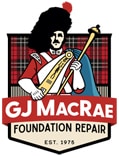Structural damage can be caused by natural disasters, accidents, or simply age. Over the past 43 years, the team at GJ MacRae Foundation Repair have helped homeowners throughout the Greater Toronto Area recover from a host of damage-causing mishaps. But how can you identify this type of problem? Here are some pro tips to help you spot structural damage in your home:
Bowing and Bulging
Curvature or bulging of interior walls is a sign that the internal support structure is inadequate or too weak. This can be caused by walls that are built too thin to hold up the weight of ceilings or upper floors. It can also be caused by vibration due to heavy traffic or industry nearby. When this happens, it usually means that the walls or joists, beams, and partitions need to be reinforced.
Sticking Doors and Windows
If your doors seem stuck or are hard to latch, or you have trouble opening and closing the windows, it could be a sign that your foundation is settling. This problem can also be caused by shifting soil. You can check to see if this is the case by going outside and performing a visual inspection of your exterior walls. Looking from the corner of each wall along the length, look for sloping, curving, or leaning. The problem may be slight at first, so double-check by using a level.
Cracks in Masonry and Foundation
Foundation cracks are a very common structural issues. Cracks can develop over time as the materials shrink and swell from seasonal freezes and thaws. Large trees or shrubbery planted close to the foundation can also disrupt your home’s structural integrity. As with walls, you should pay attention to the severity and progress of the cracks. You should also inspect your foundations regularly for deterioration or crumbling, which is often due to prolonged exposure to moisture.
The inspection should extend to your basement or crawlspace to check support beams and posts to make sure they’re straight and show no signs of mildew or rot. The bottoms of posts should rest level and firmly on the piers. Keep an eye out on for water stains, mold, and puddling on the walls and ceilings.
Cracks and crevices are one of the most common issues with concrete foundations, brick, and masonry. However, not all cracks present a major problem. These types of materials are porous and often develop tiny fissures and crevices with time. The shape and trajectory of the cracks will tell you a lot. Here’s what to look for:
- Hairline cracks between bricks or concrete blocks are normal and usually harmless.
- If you find cracks on an L-shaped section of your foundation that get narrower and taper off to nothing, it’s usually due to shrinkage. These can be patched.
- When you see cracks that are occurring in a stair-step pattern along the mortar joints, it bears further investigation. They are often due to water weight extending from a stopped-up gutter that’s putting pressure on the wall. Anything wider than one-quarter of an inch should be tended to immediately.
- Horizontal cracks in a foundation are the most serious of all. This means that moisture or damp soil is seeping into the foundation, where it freezes and expands and then dries out, or where it thaws and contracts. Each time this happens, it will weaken the area and eventually break sections of the foundation. The solution can range from repairing that section to partial or total foundation replacement.
Cracks on Walls and Around Windows or Door Frames
The state of the area around window sills or door frames can tell you a lot about what’s going on beneath your walls. Cracks in lintels indicate they’re failing, which can lead to a collapse in that area. The problem can be due to rot from moisture damage or from structural shifting. Cracks and movement in the window sills indicate the presence of moisture inside the walls. The first solution is to find and correct the source of the moisture.
Diagonal cracks from the corner of the door frame or tops of the windows usually occur on load-bearing walls. Because openings around doors and windows tend to be the weakest point on the walls, you’ll notice that cracks caused by shifting walls will begin there. They could be an indication that the footings supporting your home may be sinking.
Not all wall cracks mean that your home is in danger of falling apart. You can check the progress of crevices to determine if they pose a more serious problem underneath by measuring them. Mark the end point of the crack with a carpenter’s pencil and write down the date. You should also take note of the width. Hairline cracks smaller than 5mm in width that don’t widen, or spread can usually be taken care of with a little plaster. If you notice the crevice widening or growing beyond your original pencil mark, that means something more serious is occurring. In that case, you need to act fast and find professionals experienced in foundation repair.
Sagging Floors and Roofs
Older homes or houses built where the water table is high may begin to show signs of settling when the floors sag, meaning the foundation needs to be reinforced. Other causes of sagging or sloping floors are improperly installed footers or sub-flooring, deteriorating support beams, and moisture damage.
Sagging on the roof is a sign of a serious problem that will affect more than just the single wall. It’s usually related to leaks or excessive moisture causing advanced rot in the substrate. This problem requires a professional inspection and solutions as soon as possible. By the time it’s visible, the conditions have been deteriorating for some time.
You don’t have to wait until a small problem leads to a major repair, though. Call +1 (800) 361-3108 at the first sign of trouble or contact GJ MacRae Foundation Repair to request a quote today.








